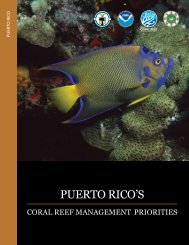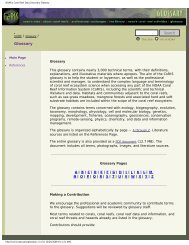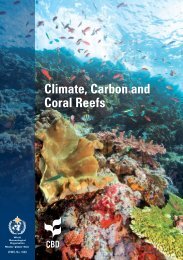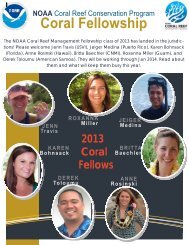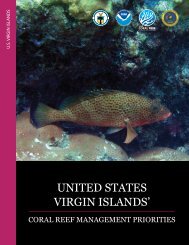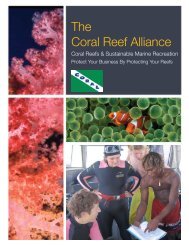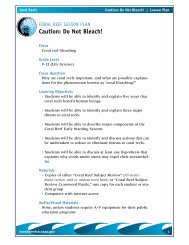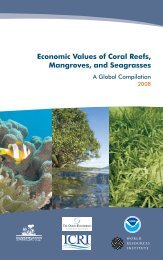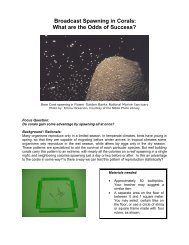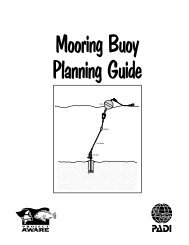Deep-Sea Coral Collection Protocols - NOAA's Coral Reef ...
Deep-Sea Coral Collection Protocols - NOAA's Coral Reef ...
Deep-Sea Coral Collection Protocols - NOAA's Coral Reef ...
- No tags were found...
Create successful ePaper yourself
Turn your PDF publications into a flip-book with our unique Google optimized e-Paper software.
<strong>Deep</strong>-sea coral habitat and rangeby Peter EtnoyerWhen most people think of coral reefs, theythink of shallow water tropical reefs. However,deep coral communities of some type lie off theshore of most coastal nations and states, asdeep as 6000m. Contrary to popular opinion,both the hard scleractinian hexacorals (thezoantharia) and softer gorgonaceous octocorals(the alcyonaria) have vertical ranges exceeding6000m. They range worldwide. The higher leveltaxa (families) are generally cosmopolitan, withsome worlwide genera, and some strictlyregional genera.Depth and frequency of occurrence for selecteddeep-sea coral families0 400 800 1200 1600 2000 2400 2800Depth (m)Primnoidae (n=925)Paragorgiidae (n=257)Isididae (n=335)Antipathidae (n=208)70%60%50%40%30%20%10%0%Frequency of occurrences3Fig. 4. Depth and frequency for some Northeast Pacificoctocoral families (from Etnoyer and Morgan 2005).Perhaps the deepest known coral taxon is a seapen — genus Umbellula, from 6620m(Williams, 1999). Primnoids occur as deep as 5850m (S. Cairns, pers. comm.) and thrive inabundance as deep as 3000m (A. Baco-Taylor, pers. comm.). The deepest known bamboo coralKeratoisis profunda, at 4851m (Cimberg, 1981) near the Northwest Hawaiian Islands. Hydrozoan‘lace corals’ have a worldwide distribution but are most common near islands and seamounts. Lacecorals have a vertical range from 0.5 to 2,787m (Cairns, 1992). Ahermatypic ‘thickets’ of Lopheliapertusa in the Gulf and the US South Atlantic bight are generally found between 200 and 1000m(Schroeder et al. 2005).) Most of the coelenterate families that contain deep-sea corals include shallowwaterspecies, too.<strong>Deep</strong>-sea corals can occur in many assemblages, including monotypic scleractinian bioherms (e.g.Lophelia sp. in the Atlantic), monotypic octocoral fields or meadows in mixed substrates on low reliefmounds (e.g. Callogorgia and Acanella in the Gulf of Mexico) or diverse rocky reefs of octocorals,anemones and sponges (e.g. New England and Gulf of Alaska <strong>Sea</strong>mounts, Aleutian and HawaiianIslands). Beginning in the North Atlanticand traveling clockwise around thecountry, we find Paragorgia sp.bubblegum corals are common to1600m on the New England seamounts(L. Watling, pers. comm.). Rare andfascinating octocorals like the beautifulMetallogorgia and Iridogorgia brightstony corals like Enallopsammiapictured here are also found there(Watling and Auster, 2005). SouthFig. 5. Stony corals and whip corals on hardbottom habitat.





